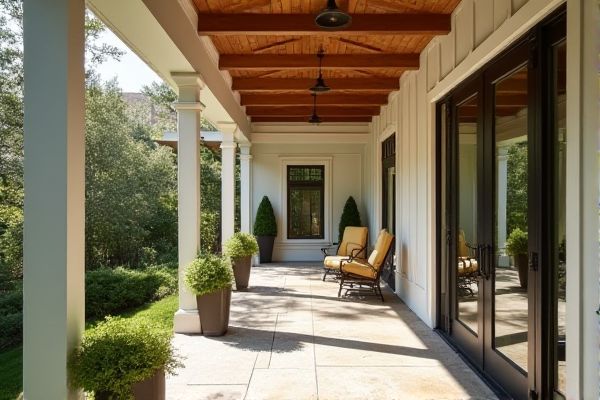
An open lattice roof allows natural light and airflow, creating a breathable and airy porch environment, while a solid roof provides full protection from rain and sun, offering greater shelter and privacy. Discover which roof option best suits Your porch needs by exploring the detailed comparison in this article.
Table of Comparison
| Feature | Open Lattice Roof | Solid Roof |
|---|---|---|
| Material | Wood, metal, or vinyl lattice panels | Metal, wood, shingles, or polycarbonate |
| Light Transmission | Partial sunlight, dappled shade | Complete shade, blocks sunlight |
| Weather Protection | Limited; does not block rain or wind | Full protection from rain, wind, and UV |
| Ventilation | High airflow, natural ventilation | Limited airflow, enclosed space |
| Installation Cost | Lower material and labor costs | Higher costs due to materials and complexity |
| Durability | Moderate; depends on material and maintenance | High; robust and long-lasting |
| Use Case | Visual appeal, garden enhancement, partial shade | Full weather protection, year-round use |
| Maintenance | Lower; cleaning and occasional repainting | Moderate; inspections and repairs as needed |
Introduction to Porch Roofing Options
Porch roofing options include open lattice roofs and solid roofs, each offering distinct benefits for your outdoor space. Open lattice roofs provide partial shade and ventilation, creating a breezy, light-filled environment ideal for hot climates. Solid roofs deliver full protection from rain and sun, ensuring your porch remains usable in all weather conditions.
What Is an Open Lattice Roof?
An open lattice roof consists of crisscrossed strips of wood or metal forming a grid that allows sunlight and air to pass through while providing partial shade. This design promotes ventilation and creates a visually appealing pattern of light and shadow, ideal for porches in warm climates. Unlike solid roofs, open lattice structures do not offer full protection from rain, making them suitable for aesthetic and cooling benefits rather than complete shelter.
What Is a Solid Porch Roof?
A solid porch roof consists of durable, opaque materials like metal, shingles, or polycarbonate panels that provide full protection from rain, sun, and wind. This roofing style ensures your porch remains a comfortable, weatherproof space year-round, preserving the area beneath it from harsh environmental elements. Unlike an open lattice roof, a solid porch roof enhances privacy and insulation, making your outdoor space more versatile for various activities.
Aesthetic Differences: Lattice vs Solid Roof
Open lattice roofs create a visually airy and textured aesthetic by allowing natural light and shadows to play through the grid pattern, adding depth and dynamic appeal to porch spaces. Solid roofs provide a clean, uniform appearance that offers a sleek, contemporary or traditional look depending on materials, emphasizing shelter and defined structure. The choice between lattice and solid roofs significantly influences the porch's overall ambiance, balancing openness and protection.
Light and Shade Considerations
Open lattice roofs allow filtered sunlight to pass through, creating dynamic patterns of light and shade that change throughout the day, enhancing the visual appeal of a porch. Solid roofs provide consistent, complete shade, protecting from harsh sunlight and rain but reducing natural light beneath the porch area. Choosing between these options depends on desired light intensity, weather protection, and the aesthetic effect of shadows on outdoor living spaces.
Weather Protection: Comparing Coverage
Open lattice roofs provide partial weather protection by allowing some sunlight and rain to filter through, making them ideal for shaded outdoor spaces without complete shelter. Solid roofs offer comprehensive coverage, blocking rain, snow, and intense sunlight entirely, ensuring your porch remains dry and comfortable in all weather conditions. Your choice depends on the level of protection needed against elements like precipitation and UV exposure.
Maintenance and Durability
Open lattice roofs require less frequent maintenance due to their design allowing water and debris to pass through, reducing the risk of mold and rot compared to solid roofs. Solid roofs provide superior durability against harsh weather conditions by offering complete protection, but they may need regular inspections and cleaning to prevent damage from trapped moisture. Your choice depends on balancing low upkeep with long-lasting shelter, where open lattice suits low maintenance and solid roofs excel in durability.
Cost Comparison: Lattice vs Solid Roof
Open lattice roofs typically cost less than solid roofs due to lower material and installation expenses, making them a budget-friendly option for porches. Solid roofs involve higher costs because of materials like metal or shingles and require more labor-intensive installation. Your choice depends on balancing initial investment against long-term durability and weather protection needs.
Impact on Home Value and Outdoor Living
An open lattice roof enhances your porch by creating a visually appealing, partially shaded space that boosts curb appeal and outdoor living enjoyment, often increasing home value through its aesthetic charm. In contrast, a solid roof offers full weather protection, extending usability of the outdoor space in all seasons and potentially raising property value by adding functional living areas. Choosing between the two depends on whether you prioritize natural light and ventilation or year-round shelter and privacy.
Which Porch Roof Is Right for You?
An open lattice roof offers a breathable, light-filtering design ideal for creating a shaded outdoor space while allowing air circulation, making it perfect for warmer climates or gardens requiring partial sunlight. In contrast, a solid roof provides complete protection from rain, sun, and debris, ensuring a dry and sheltered porch suitable for year-round use and more privacy. Choosing the right porch roof depends on your local weather conditions, desired level of shade and protection, and how you plan to use your outdoor space.
 homyna.com
homyna.com